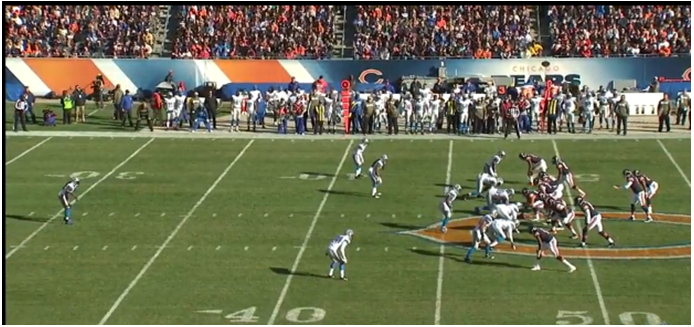The concept, at its core, involves reading a flat defender, typically an outside linebacker. This becomes dangerous when inside linebackers follow your quarterback’s eyes to the side of the field he is throwing to. The best way to prevent this is to have a “box route”. A box route is a route that hitches between 5-10 yards infront of the center. This route is crucial to the full development of the read.
Curl-flat is known as a ball control type of play. It is not
known for its ability to create explosive plays. The curl is the deepest route,
and most of the time typically breaks from 8-10 yards at the high school level.
Too often the timing of the play is thrown off by poor receiver splits, route
technique, and pressure on the quarterback. Too often the receiver running the
curl either drifts inside too much or too little.
An adjustment that I have seen throughout the NFL the past
few seasons alleviates these problems. The play is run from a pseudo-2x2 bunch
formation. #1 reduces their splits to that of a slot receiver, and the slots
become H-backs. The H-backs are typically running backs or tight ends. By attaching
the slots to the end of the line of scrimmage and the ability to use three
running backs/tight ends, this play applies not only to spread teams, but
wing-T and flexbone triple option schemes as well. Below is a screen capture of
Marc Trestman, the head coach for the Chicago Bears, utilizing this formation
against the Detroit Lions.
Credit: NFL.com
The outside receivers will run the curl routes. When
pressed, they will attack the outside hip of the corner until he turns his
hips, then they will slip inside to get on the same vertical line that they
began on. The outside stem typically only lasts for the first 3 yards. If they
are not pressed, they will run in a straight line. The depth of the curl will
be set at 13-15 yards, depending on how comfortable you are with your
quarterback’s arm strength. The receiver will not “curl”, instead he will hitch
and drive back to the quarterback for a step or two. This allows the
quarterback to throw to a spot and anticipate where the route will be. The
design of the route does not allow for interpretation, so the receiver will not
have to "find the open window" as he is already in the window. This
timing is what will create big plays. The corner will not have as much time to
react and the receiver will have more room for yards after the catch.
The H-backs will chip or “nudge” the defensive end before
running a flat route. This gives the quarterback more time to throw as well as
synchronizes the timing with the break of the curl route. The curl route will
break right behind the back of the H-back, optimizing the timing with the
quarterback. The running back next to the quarterback will nudge on the inside
and run the box route at 5 yards over the center, acting as a check down if the
inside linebackers vacate to the curls. If one of the inside linebackers blitz,
the running back is responsible for blocking them. If the defense blitzes one
of the inside linebackers, there is no need for the box route anymore, as there
is either one or zero players that can undercut the two curl routes.
The next screen capture shows the stems of the curl routes
about to break as the H-backs are releasing after helping out the offensive
tackle. The running back next to the quarterback, Matt Forte, recognizes the 6
man pressure as the middle linebacker blitzes. Forte blocks him instead of
releasing to his route and allows the quarterback, Jay Cutler, time to set up
for the longer developing curl patterns. Jay reads the outside linebacker and
sees that his hips have turned to run with the flat route, opening up the window
for the curl.
Credit: NFL.com
The final screen capture shows Alshon Jeffery high pointing
the football as the separation between him and the corner is about 3 yards.
This separation is due to the timing of the play, as Jay Cutler threw the ball
right behind the vacating outside linebacker following Martellus Bennett to the
flat route.
Credit: NFL.com
The curl-flat concept has been in football for a long time,
but a couple of tweaks to the classic version of the play can create more
efficiency along with big play potential. This version can be utilized in any
offensive system and requires less teaching than the original version of the
play.



No comments:
Post a Comment